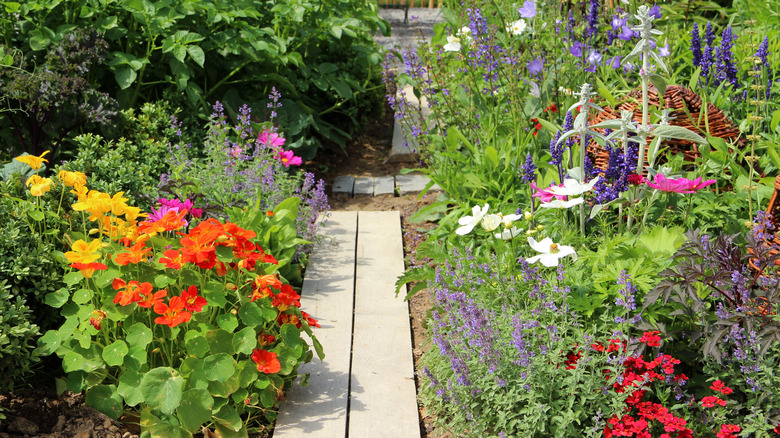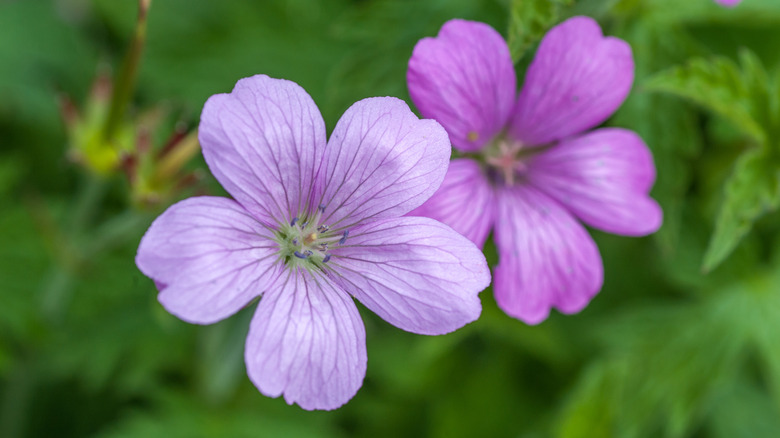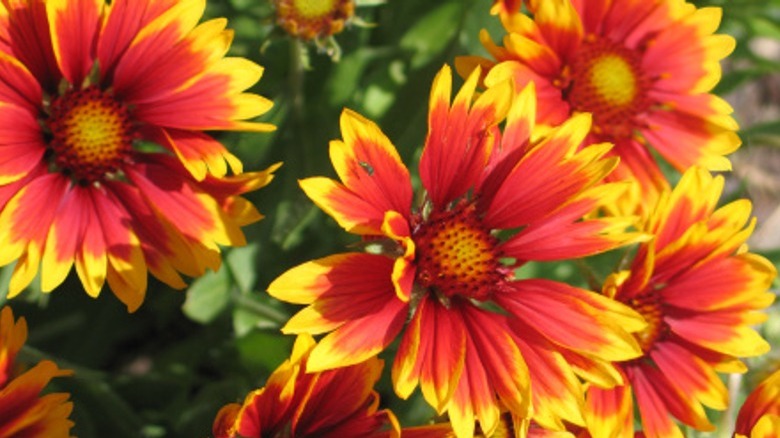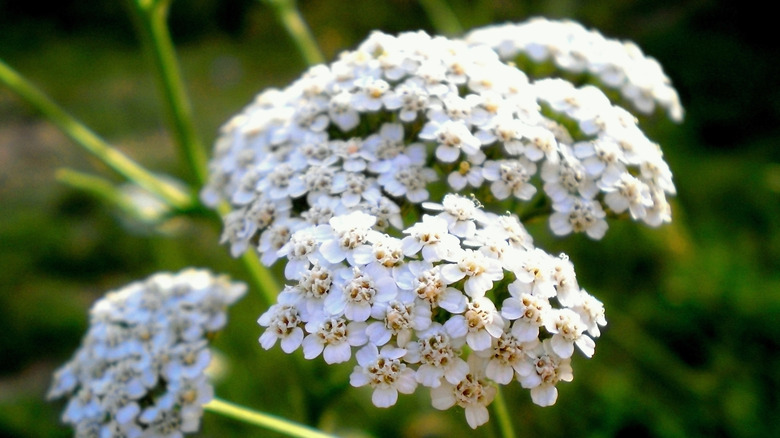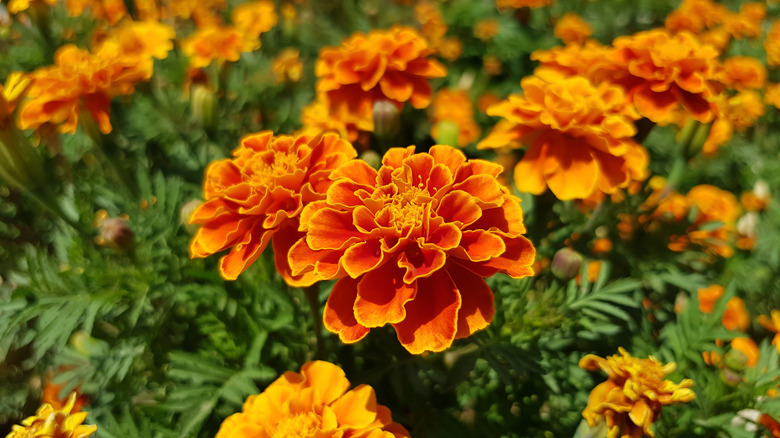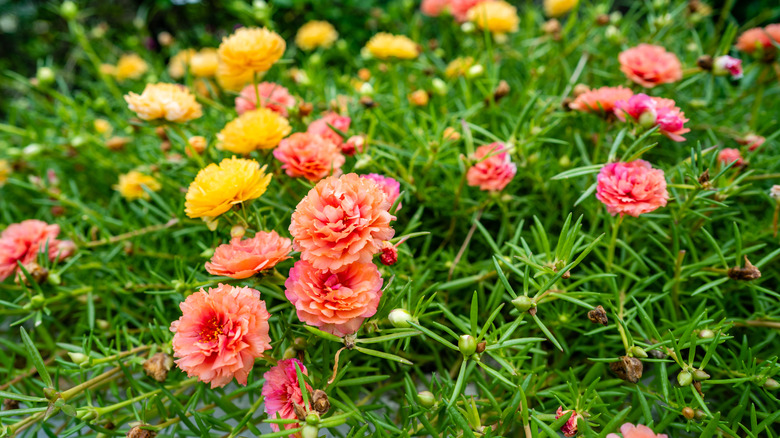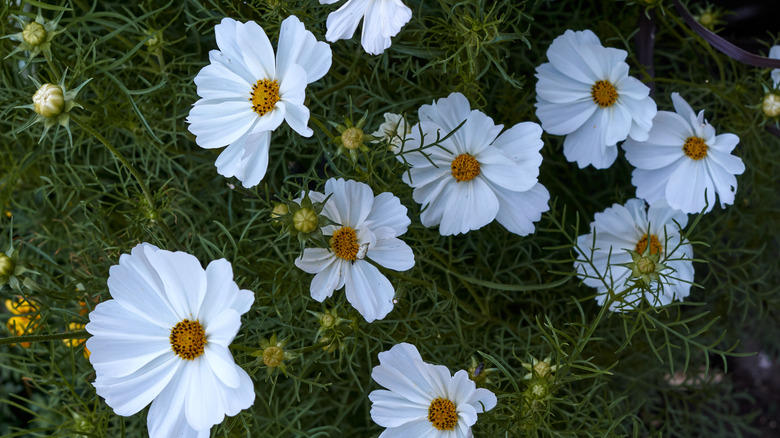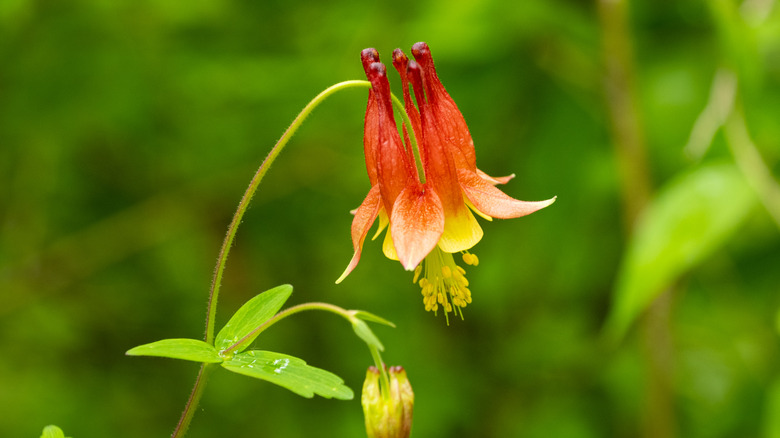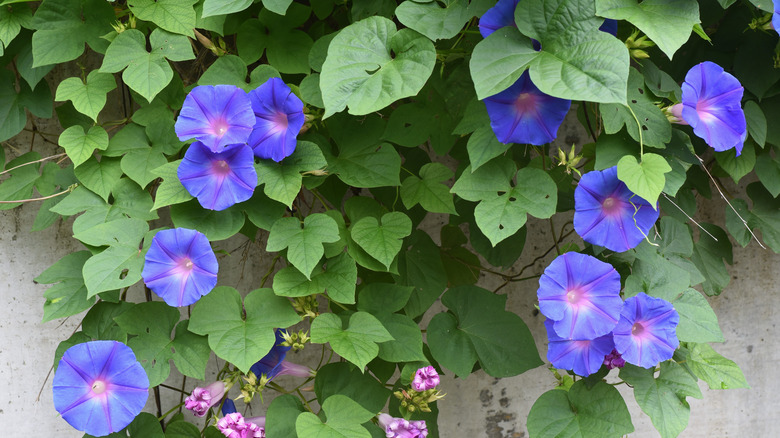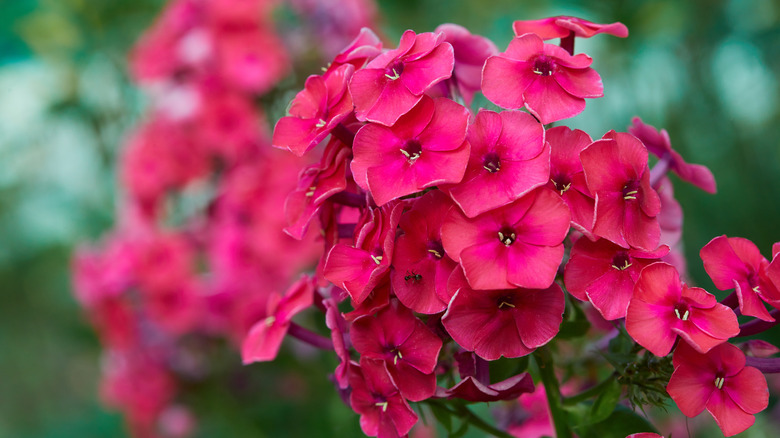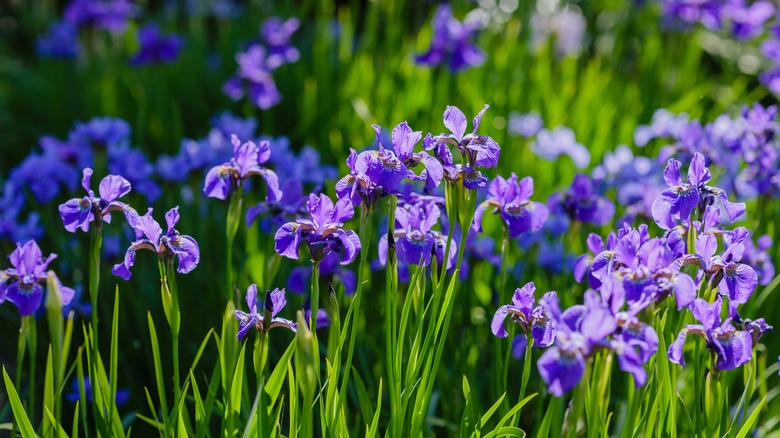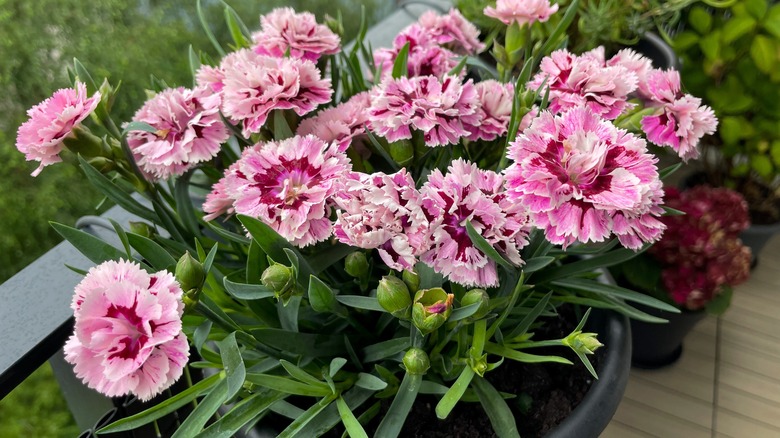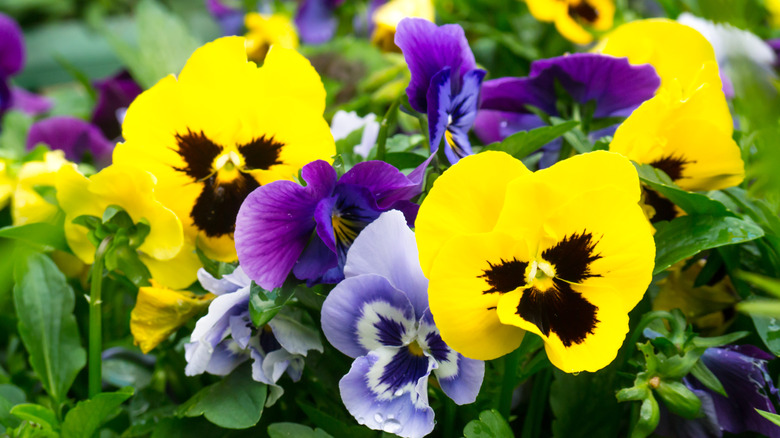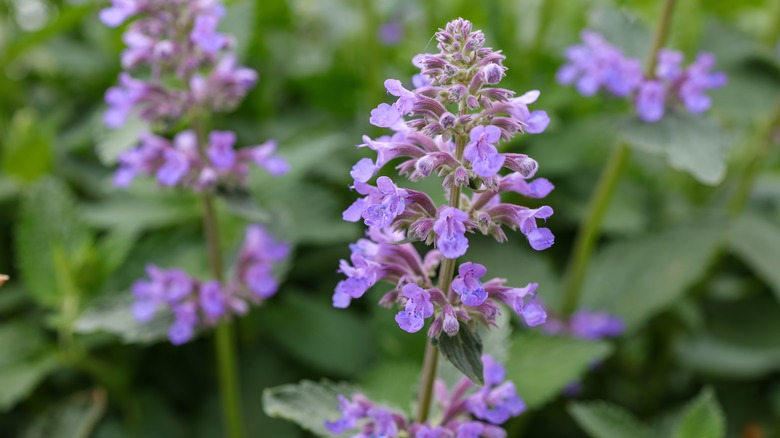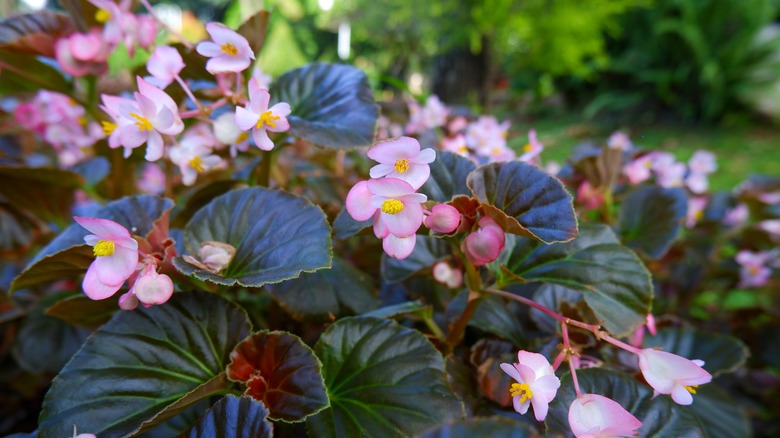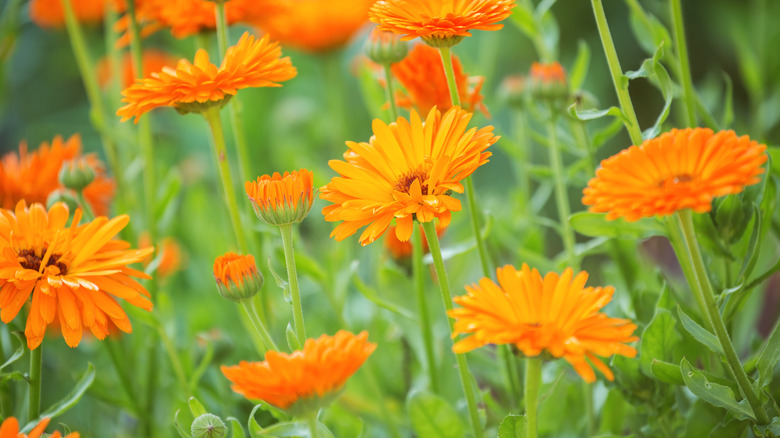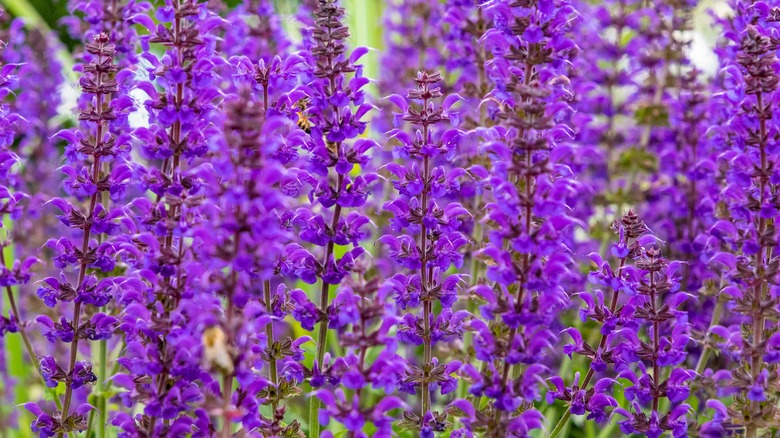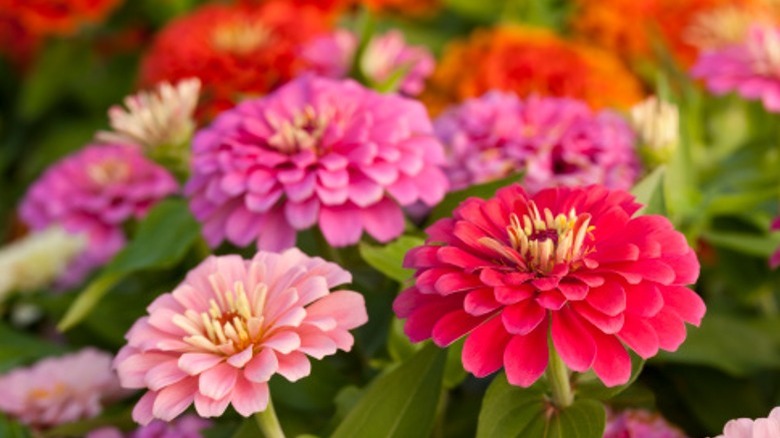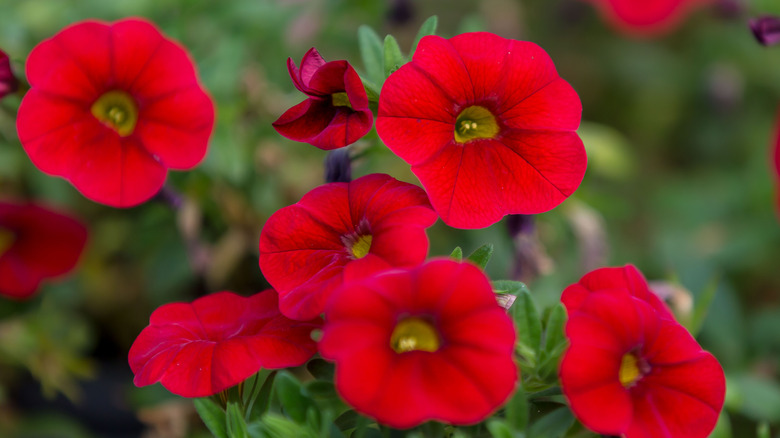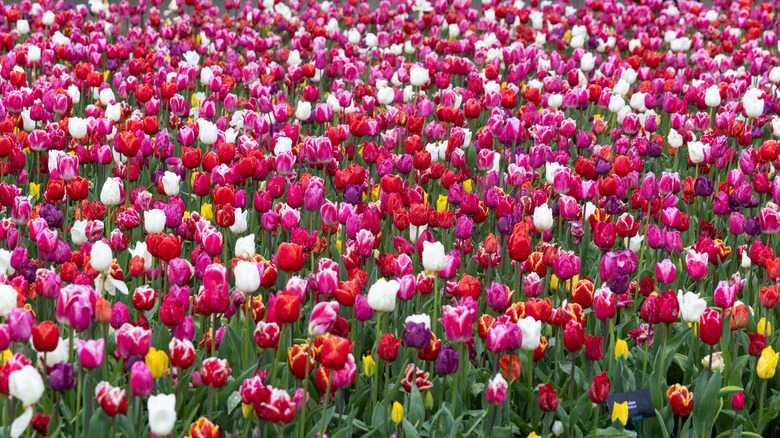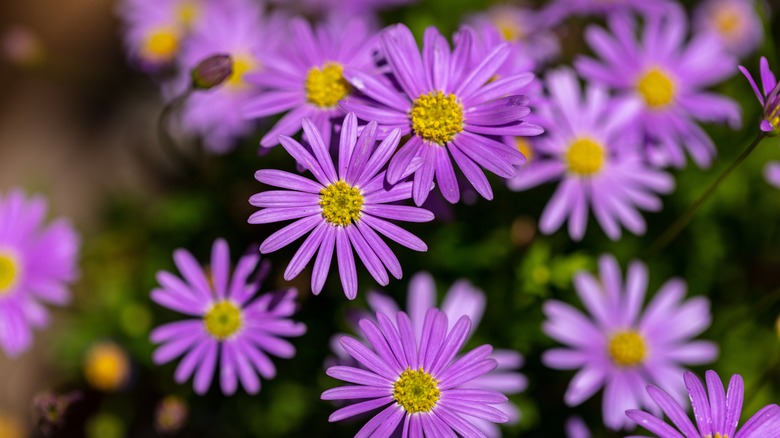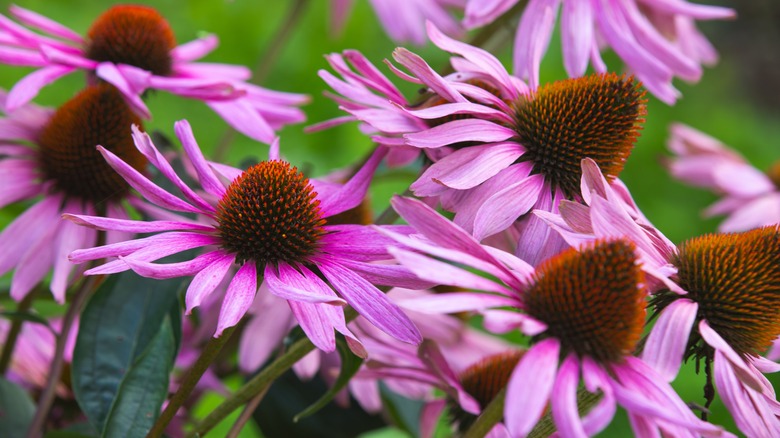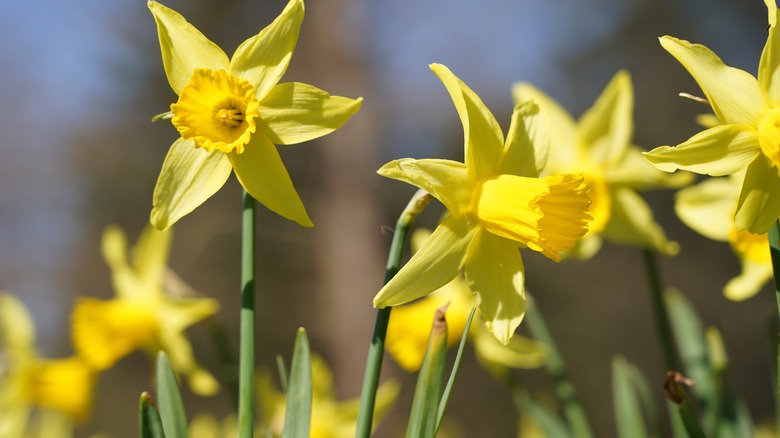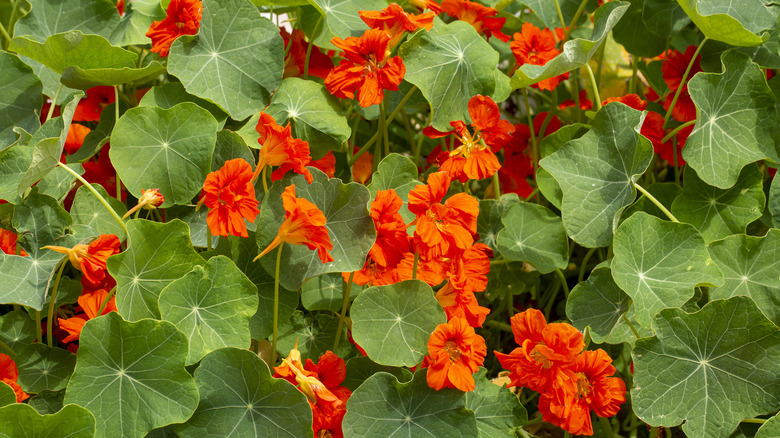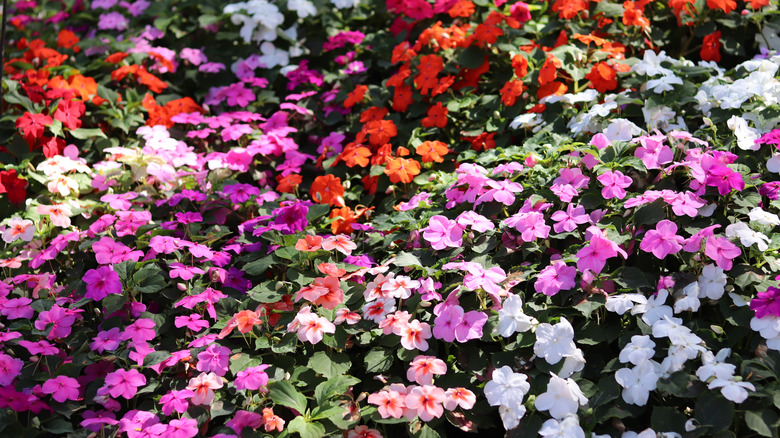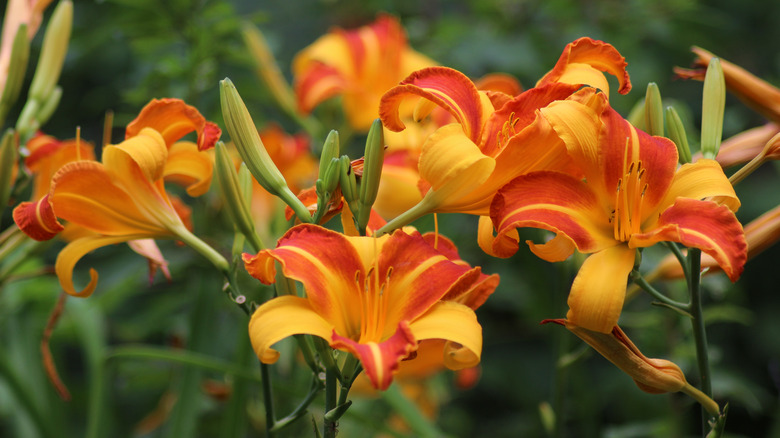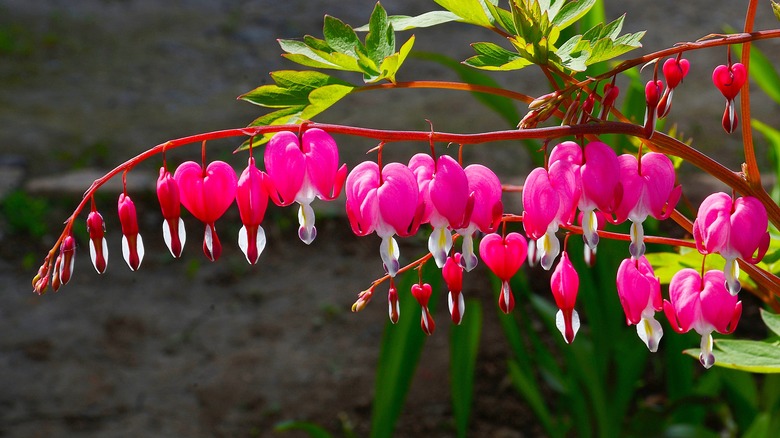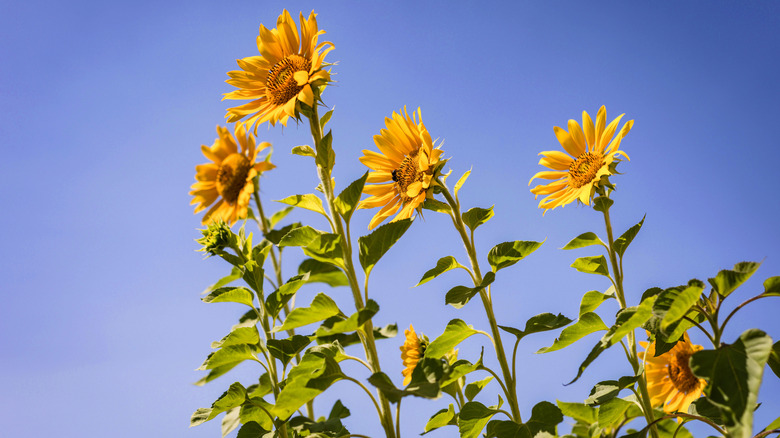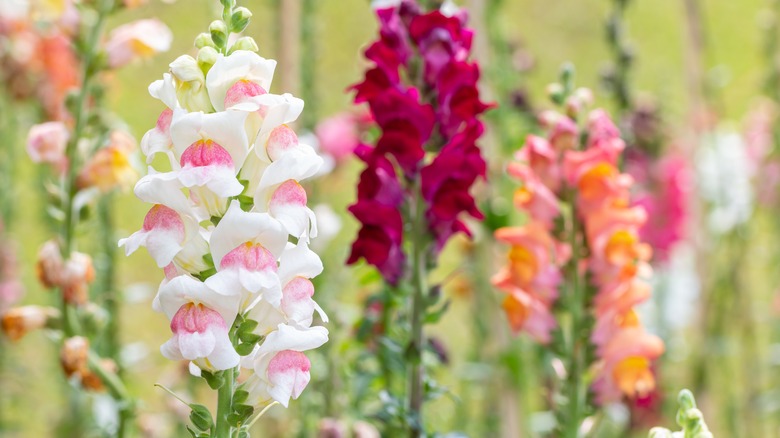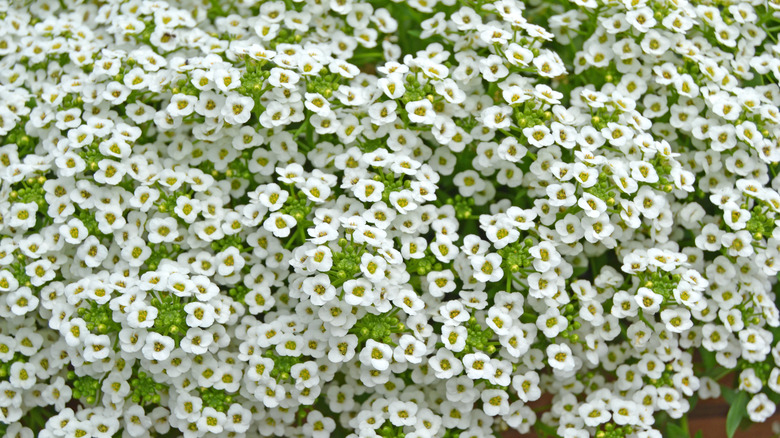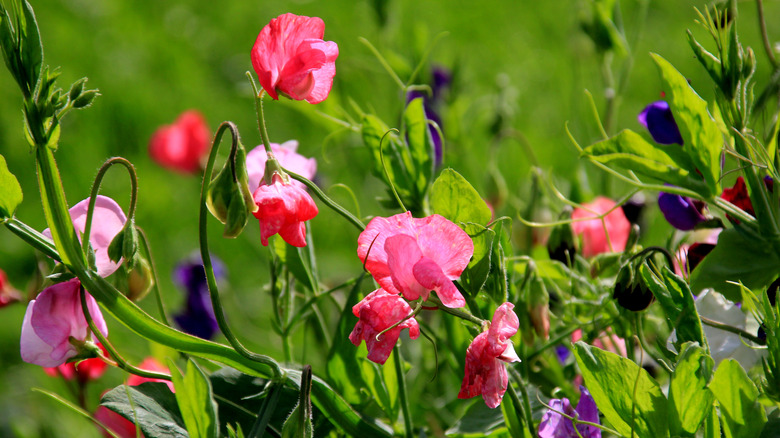Flowers That Even The Worst Gardeners Can Handle
If you thought gardening was easy, you likely had a rude awakening when you started getting your hands dirty. From preparing the soil to watering your freshly transplanted babies for the first time, there are countless instances where you could make a gardening mistake. This is especially true if you decide to start your home gardening journey with a finicky plant that needs extremely specific conditions to grow properly. These sorts of plants can't handle the weather being too cold, hot, humid, salty, or dry depending on their species, among hundreds of other small things including too acidic soil, too frequent watering, and too much direct sunlight.
When you've had one too many plant deaths in the past, you might think you're the worst gardener in the world. But, we think you just haven't met the right plants yet. Here, we found a whopping 30 flowers that inexperienced and unskilled gardeners can grow with only a small chance that they won't survive. In general, these flowering plants can be planted in average soil and watered on a semi-regular basis. With minimal effort, we believe that you can handle every one of these flowers (though maybe not all at the same time).
1. Crane's bill
Crane's bill (Geranium maculatum), also sometimes simply called geranium or wild geranium, is a flower native to the United States. In general, growing plants in your garden that are native to your area will be easier to maintain. Crane's bill is specifically native to the Northeastern U.S., but it has also been found growing as far west as the Dakotas and as far south as Florida and Louisiana.
Bloom Season: Spring to summer
USDA Growing Zone: 3 to 8
Growing Conditions: Partial to full shade
Soil Type: Evenly moist and well-draining
Size: 1 to 2 feet tall
2. Gaillardia
Gaillardia, or the blanket flower (Gaillardia spp.), is popular in blooming summer and autumn gardens. A member of the daisy family, it is quite easy to grow and tolerant of drought, salt, neglect, and browsing animals. Typically the flowers are colored in shades of yellow, orange, and red, but some Gaillardia varieties may show pink and purple gradients.
Bloom Season: Summer to fall
USDA Growing Zone: 3 to 9
Growing Conditions: Full sun
Soil Type: Gritty and well-draining
Size: 48 inches tall and 30 inches wide
3. Yarrow
Yarrow (Achillea millefolium) is another member of the daisy family that inexperienced gardeners flock to. It can naturalize and spread quickly, even without human intervention. The flowers it produces are very small and cluster together on erect stems. Some popular varieties feature red, pink, or white blooms, which also attract pollinators like bees and butterflies.
Bloom Season: Summer
USDA Growing Zone: 3 to 9
Growing Conditions: Full sun
Soil Type: Nutrient-poor and well-draining
Size: 1 to 3 feet tall and wide
4. French marigolds
French marigolds (Tagetes patula) are a mounding annual that feature dense dark green leaves and 1 to 3-inch wide flower heads that may be red, orange, or yellow. Depending on the variety you choose, marigolds may have single, semi, double, or crested blooms that show themselves from spring to fall.
Bloom Season: Spring to fall
USDA Growing Zone: 2 to 11
Growing Conditions: Full sun to partial shade
Soil Type: Well-draining
Size: 6 to 12 inches tall
5. Portulacas
Portulaca, also known as the moss rose (Portulaca grandiflora), is a ground cover plant that produces rose-like blossoms, hence its common name. Once planted in a sunny location, the flower requires little care due to its low need for water. For gardeners that tend to forget about their plants, the moss rose is perfect.
Bloom Season: Spring to summer
USDA Growing Zone: 2 to 11
Growing Conditions: Full sun
Soil Type: Well-draining and rocky
Size: 3 to 8 inches tall and 1 foot wide
6. Cosmos
Cosmo flowers (Cosmos bipinnatus) are widely loved for their 2 to 4-inch-wide flowers that come in several bright colors. However, their best feature is that they can be grown in almost any type of soil as long as it's well-draining. With plenty of sunlight, these flowers are prolific growers that can bloom for many months.
Bloom Season: Summer to fall
USDA Growing Zone: 5 to 9
Growing Conditions: Full sun
Soil Type: Well-draining
Size: 4 feet tall and 3 feet wide
7. Columbine
Columbine flowers (Aquilegia canadensis) can be identified by their bright red blooms that hang off arching stems. The rest of the plant is fairly large, featuring green leaves split into three leaflets and tall erect branches that can become as tall as 2 feet. Similar to our previous plants, columbine can withstand a variety of growing conditions. It succeeds in full sun, full shade, periods of drought, and even beneath large deciduous trees.
Bloom Season: Early spring
USDA Growing Zone: 3 to 8
Growing Conditions: Full sun to full shade
Soil Type: Well-draining
Size: 2 feet tall
8. Morning glories
The morning glory plant (Ipomoea indica) is extremely popular for growing on trellises or in hanging baskets because of its trailing habit. Despite its popularity, the flower is considered weedy and invasive in some warmer climates where it will spread widely. However, in USDA zones colder than 8, morning glories will only grow as annuals as they can't withstand temperatures below 20 degrees Fahrenheit.
Bloom Season: Spring to fall
USDA Growing Zone: 8 to 11
Growing Conditions: Full sun
Soil Type: Loamy and well-draining
Size: 4 to 15 feet tall and 2 to 3 feet wide
9. Garden phlox
Garden phlox (Phlox paniculata), which is native to the Eastern United States, is a long-blooming perennial. It can take a bit of effort to care for after planting, but the maintenance is straightforward. With some regular watering and the right kind of soil, growing it should be a breeze. This is especially true if you live on the East Coast where it often grows without help.
Bloom Season: Summer to fall
USDA Growing Zone: 4 to 8
Growing Conditions: Full sun to partial shade
Soil Type: Fertile, moist, and well-draining
Size: 2 to 4 feet tall and wide
10. Siberian irises
If you have a particularly moist section of your landscape, the Siberian iris (Iris sibirica) might be right for you. Typically growing along streambanks, nearby ponds, or in rain gardens, this iris species is an adaptable spring bloomer. It shows off gorgeous blue to violet petals and grows fast as long as it's given direct sunlight and plenty of moisture.
Bloom Season: Spring and summer
USDA Growing Zone: 3 to 9
Growing Conditions: Full sun to partial shade
Soil Type: Moist, fertile, and well-draining
Size: 2 to 4 feet tall and wide
11. Dianthus
Dianthus (Dianthus caryophyllus), which are more commonly known as carnations, are annual flowers that are frequently grown for cutting and use in bouquets or other floral arrangements. If you live in a temperate region, carnations are surprisingly easy to grow. Among their only sensitivities are high temperatures.
Bloom Season: Spring and summer
USDA Growing Zone: 6 to 9
Growing Conditions: Full sun to partial shade
Soil Type: Organic, gritty, and well-draining
Size: 1 to 4 feet tall and 1 foot wide
12. Pansies
Pansies (Viola tricolor var. hortensis) are loved around the world for their delicate multi-colored flowers that bloom for several months. Even better, they are extremely easy to grow no matter how much gardening experience you have. This is due to their adaptable nature that lets them grow in a range of soil types and sunlight strengths.
Bloom Season: Spring to fall
USDA Growing Zone: 2 to 9
Growing Conditions: Full sun to partial shade
Soil Type: Evenly moist and well-draining
Size: 4 to 20 inches tall
13. Catmint
Garden catmint (Nepeta racemosa) is a low-maintenance perennial that features fragrant leaves and blue flowers that appear in the summer. Their intense drought tolerance makes them a great candidate for unsuccessful gardeners who forget to water their plants as much as they should. They also can be planted in a variety of ways including in containers, as a border, or in rock gardens and cottage gardens.
Bloom Season: Summer
USDA Growing Zone: 4 to 8
Growing Conditions: Full sun to partial shade
Soil Type: Dry and well-draining
Size: 24 to 30 inches tall and 30 to 36 inches wide
14. Hardy begonias
Hardy begonias (Begonia grandis) are gorgeous late-bloomers that produce pink flowers and green leaves with a bushy habit. Unlike other begonia species, this one can be grown as a perennial in colder states without much damage. Once established in a shady location, hardy begonias should simply need regular watering to keep their soil moist.
Bloom Season: Summer and fall
USDA Growing Zone: 6 to 7
Growing Conditions: Full shade to partial shade
Soil Type: Organic, moist, and well-draining
Size: Up to 2 feet tall and wide
15. Calendulas
Calendulas (Calendula officinalis), which are more often referred to as pot marigolds, are edible flowers in the daisy family. The petals are commonly used in soups, salads, and rice dishes where they add peppery flavor. They grow best in containers and nearby walkways, but the low-maintenance plants will grow almost anywhere that provides them with some sunlight and well-draining soil.
Bloom Season: Spring to fall
USDA Growing Zone: 2 to 11
Growing Conditions: Full sun to partial shade
Soil Type: Moist and well-draining
Size: 1 to 2 feet tall and wide
16. Meadow sage
Meadow sage (Salvia pratensis) is one of many species in the sage family. Like other salvias, it is drought-tolerant and loves direct sunlight. The flowering perennial blooms first in the later months of spring and normally reblooms intermittently throughout the growing season. Like other members of the Lamiaceae family, meadow sage has fragrant leaves and flowers that bees and other pollinators are attracted to.
Bloom Season: Spring to fall
USDA Growing Zone: 4 to 8
Growing Conditions: Full sun
Soil Type: Gritty and well-draining
Size: 1 to 3 feet tall and wide
17. Zinnias
Zinnias (Zinnia spp.) are one of the most well-known low-maintenance flowers. Even though they are annuals that usually need yearly replantings, they are quick to establish themselves in the soil and require nearly no attention afterward. With access to direct sunlight, the flowers will bloom with 1 to 3-inch wide blossoms that may be yellow, orange, pink, purple, red, or white.
Bloom Season: Spring to fall
USDA Growing Zone: 3 to 10
Growing Conditions: Full sun
Soil Type: Well-draining
Size: 8 to 48 inches tall and 6 to 18 inches wide
18. Petunias
You'll recognize petunias (Petunia spp.) by their trumpet-shaped blooms that come in a variety of color combinations. The petunia genus holds 20 species and hundreds of cultivars. All of these different varieties have similar growing requirements that are not difficult to meet. They need direct sunlight and average garden soil to produce their lovely blooms. Keep in mind, however, trailing or spreading petunias do need more attention compared to others.
Bloom Season: Spring
USDA Growing Zone: 10 to 11
Growing Conditions: Full sun
Soil Type: Well-draining
Size: 6 to 15 inches tall depending on the cultivar
19. Tulips
Tulips (Tulipa spp.) are a spring classic for a reason. Small and large cities alike explode with color in the spring thanks to these bulbs that bloom early in the season. If all of your neighbors can grow them, why can't you? You must plant the bulbs in the soil up to 6 inches deep in the fall and simply wait for them to bloom in the spring.
Bloom Season: Spring
USDA Growing Zone: 3 to 8
Growing Conditions: Full sun
Soil Type: Fertile, organically rich, and well-draining
Size: Up to 2 feet tall and 9 inches wide
20. New England asters
New England asters (Symphyotrichum novae-angliae) grow well in gardens across the United States with the exception of Idaho, Nevada, New Mexico, Texas, Louisiana, and Florida. The tall-growing flowers are especially popular on the East Coast where they have access to moist soil and support local pollinator species.
Bloom Season: Fall
USDA Growing Zone: 3 to 7
Growing Conditions: Full sun to partial shade
Soil Type: Moist, rich, and well-draining
Size: Up to 6 feet tall
21. Purple coneflowers
Purple coneflowers (Echinacea purpurea) are among the most popular species of coneflowers due to their easy-going habit and attractive 4-inch-wide blooms. The flowers don't grow particularly fast, however, they can reach up to 4 feet tall with good care. The most important demands of these coneflowers are well-draining soil and at least some direct sunlight.
Bloom Season: Mid-summer to late fall
USDA Growing Zone: 3 to 9
Growing Conditions: Full sun to partial shade
Soil Type: Evely moist and well-draining
Size: 4 feet tall and 2 feet wide
22. Daffodils
Daffodils (Narcissus pseudonarcissus), like tulips, are grown from a bulb and bloom in the earliest parts of spring. They are well-known for their yellow trumpet-shaped flowers and slender green stalks and foliage. Still, there isn't just one type of daffodil. There are actually over 30,000 cultivars, but only a fraction of them are available to buy for your home garden.
Bloom Season: Early to late spring
USDA Growing Zone: 3 to 8
Growing Conditions: Full sun to partial shade
Soil Type: Well-draining
Size: 6 to 16 inches tall
23. Nasturtium
Nasturtiums (Tropaeolum spp.) are versatile flowers that not only look great in the garden but also repel harmful insects and produce edible blooms. Similarly to calendula flowers, they have a peppery flavor that goes well on salads. Gardeners enjoy growing these flowers because of their low-maintenance nature and their ability to tolerate drought, neglect, and browsing animals.
Bloom Season: Summer to fall
USDA Growing Zone: 2 to 11
Growing Conditions: Full sun
Soil Type: Slightly acidic and well-draining
Size: 1 to 10 feet tall and 1 to 3 feet wide
24. Impatiens
Impatiens (Impatiens walleriana), which are sometimes known as busy lizzies, are known for their long-blooming flowers that blossom in the shade. If you are looking to brighten a particularly dark part of your garden, you can plant and forget about impatiens, which will happily grow for the summer with little intervention as long as their soil is kept somewhat moist.
Bloom Season: Spring to fall
USDA Growing Zone: 10 to 11
Growing Conditions: Full to partial shade
Soil Type: Organic, moist, and well-draining
Size: 6 inches to 2 feet tall
25. Daylilies
Daylilies (Hemerocallis spp.) can be grown almost anywhere in your garden when planted in well-draining soil and direct sunlight. The flowers are grown from tubers, which are like bulbs, that must be planted under an inch of soil to grow properly. When planted in the late fall, daylily flowers will shoot up and bloom by spring in most cases.
Bloom Season: Spring to fall
USDA Growing Zone: 3 to 9
Growing Conditions: Full sun to partial shade
Soil Type: Rich in organic matter and well-draining
Size: 1 to 3 feet tall and wide
26. Bleeding hearts
Bleeding hearts (Lamprocapnos spectabilis) are well-liked flowering plants up North and in the Midwest. They are named after their pink-red heart-shaped blooms that hang off arching stems and feature white stamens seemingly dripping from the heart. The hardy perennial is known for being low-maintenance, but gardeners should be careful not to overwater it or plant it in too much sunlight.
Bloom Season: Spring
USDA Growing Zone: 3 to 9
Growing Conditions: Full shade to partial shade
Soil Type: Evenly moist and well-draining
Size: 2 to 3 feet tall and wide
27. Sunflowers
Sunflowers (Helianthus annuus) are classic garden flowers that tower over most plants and shrubs to show off their giant heads that feature bright yellow petals and a brown-black center. However, you might not know that they are easy to grow. Sunflowers reliably grow from seed and do so quickly. As long as you water them consistently as they mature, healthy sunflowers are right at your fingertips.
Bloom Season: Summer to fall
USDA Growing Zone: 2 to 11
Growing Conditions: Full sun
Soil Type: Well-draining
Size: 2 to 10 feet tall
28. Snapdragons
Snapdragons (Antirrhinum majus) are a flower species that can be identified by their stalks filled with uniquely shaped flowers that are available in a range of colors. They grow well in normal soil in containers, garden beds, mass plantings, and as edging for walkways and other borders. In general, snapdragons can be cared for by even the worst gardener when their soil is kept moist.
Bloom Season: Spring to fall
USDA Growing Zone: 2 to 11
Growing Conditions: Full sun to partial shade
Soil Type: Evenly moist and well-draining
Size: 6 inches to 3 feet tall
29. Sweet alyssum
Sweet alyssum (Lobularia maritima) is a low-growing plant that forms clusters of sweet-smelling blooms in the spring, summer, and fall. Planted in a container, the mat-forming annual may spill over like a waterfall of flowers. You can also grow them as a ground cover on your landscape. Either way, they'll need consistent watering and some shade if you live in a hot climate.
Bloom Season: Spring to fall or year-round in warmer regions
USDA Growing Zone: 5 to 9
Growing Conditions: Full sun to partial shade
Soil Type: Well-draining
Size: 3 to 9 inches tall
30. Sweet pea
Sweet peas (Lathyrus odoratus) are best grown as annuals in temperate climates where they aren't exposed to much heat or humidity. In the right area, sweet peas will bloom from spring to fall with bright flowers that are delightfully fragrant. You can train them onto trellises or plant them directly into a garden bed depending on your preference. Just be sure that you can provide moist soil and direct sunlight.
Bloom Season: Spring to fall
USDA Growing Zone: 2 to 11
Growing Conditions: Full sun
Soil Type: Rich and well-draining
Size: 3 to 8 feet tall
